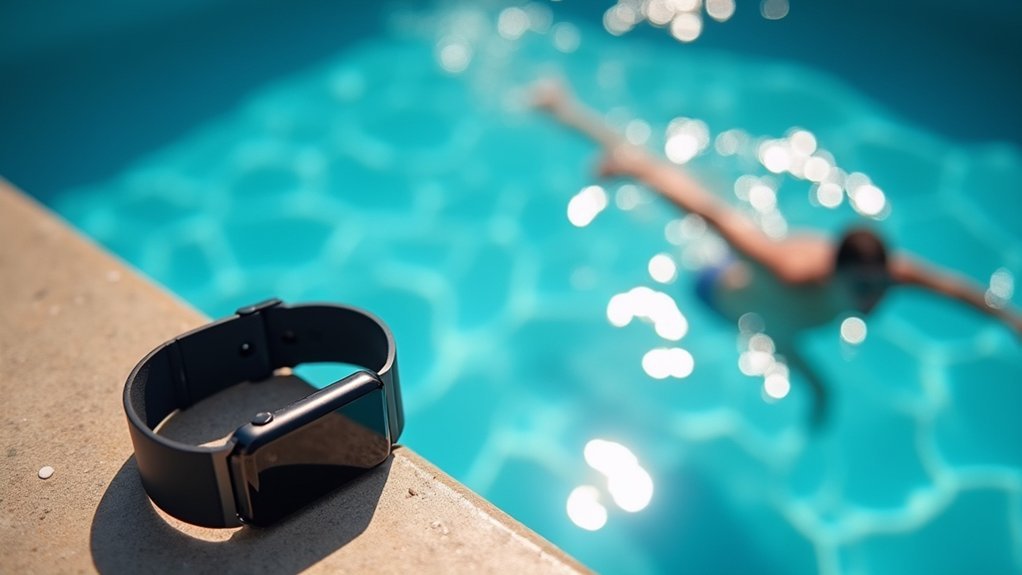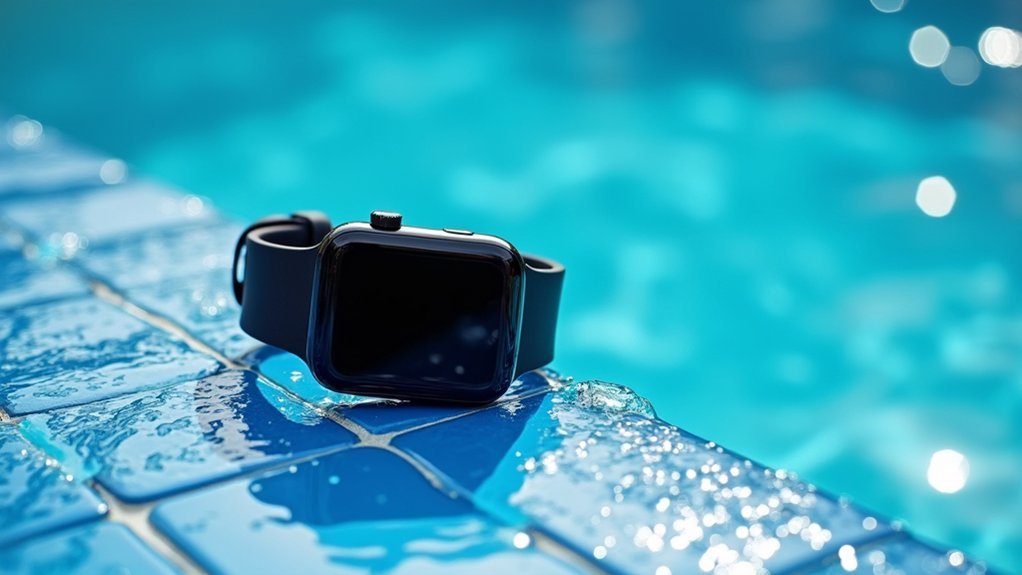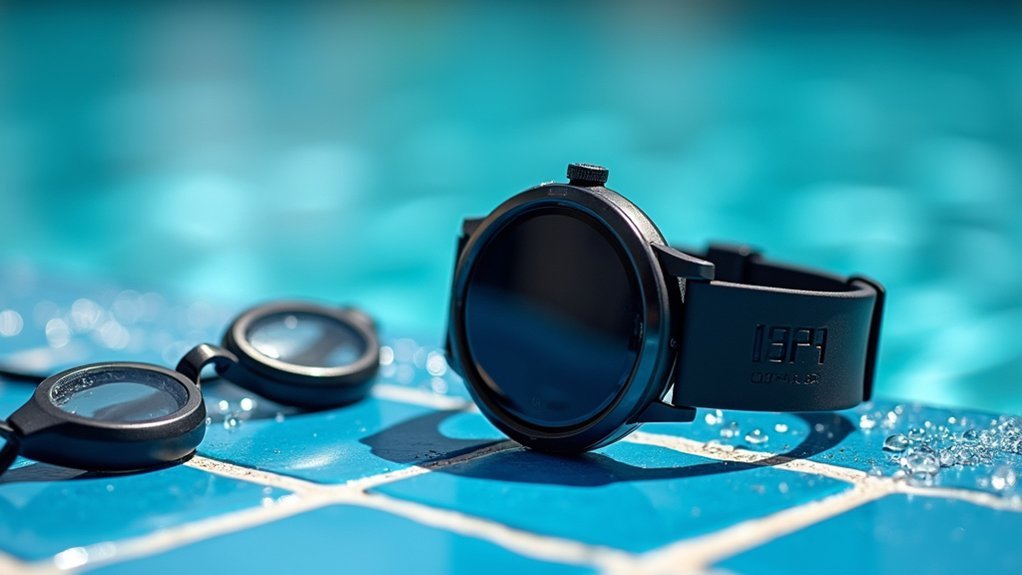When choosing a smartwatch for swimming, don’t rely solely on ATM ratings since they measure static pressure, not the dynamic forces you’ll encounter while swimming. First, opt for at least 5 ATM rating for regular pool swimming, though 10 ATM is safer for competitive swimmers. Second, look for “swim-proof” certifications rather than basic water resistance claims. Third, maintain your device by rinsing with fresh water after each session and checking seals regularly. These fundamentals will help you make smarter decisions about waterproof wearables.
Understanding ATM Ratings vs. Real Swimming Conditions

When you’re shopping for a smartwatch to wear while swimming, you’ll quickly encounter ATM ratings plastered across product descriptions—but these numbers don’t tell the whole story.
ATM stands for “atmospheres,” measuring static water pressure resistance. Each ATM equals 10 meters of theoretical pressure resistance, so 5ATM means 50 meters of static pressure.
However, ATM ratings don’t account for real swimming conditions. Movement, jumping, and splashing create dynamic pressure that exceeds static measurements. A 5ATM watch isn’t necessarily safe for swimming at 50 meters depth.
ATM ratings measure static pressure, but swimming creates dynamic forces that can overwhelm a watch’s water resistance capabilities.
Temperature changes affect seals, saltwater corrodes materials differently than fresh water, and prolonged exposure can overwhelm even high-rated devices. Over time, the water resistance of your device will naturally degrade due to normal wear and aging of seals.
You need to look beyond ATM numbers and seek explicit “swim-proof” certifications for reliable water resistance.
Choosing the Right Water Resistance Level for Your Swimming Activities
Now that you understand how ATM ratings work in theory versus practice, you need to match your specific swimming activities with the appropriate water resistance level.
For casual pool swimming and surface activities, a 3 ATM rating provides basic protection. However, competitive swimmers should prioritize 5 ATM-rated watches, which handle 50 meters depth and withstand five times atmospheric pressure. Popular options include the Apple Watch Series 8 and select Garmin models.
If you’re into snorkeling or deeper water activities, you’ll need 10 ATM ratings minimum.
Marathon swimmers require excellent water resistance plus GPS tracking capabilities. Open-water swimmers should consider that GPS functionality is essential for tracking location and distance during longer swims.
Don’t forget to take into account additional features like heart rate monitoring, stroke detection, and battery life when making your decision.
Maintaining Water Resistance Performance Over Time

Even with the highest water resistance rating, your smartwatch’s protective capabilities will deteriorate without proper maintenance.
Chlorine and salt deposits gradually damage seals, while high-pressure water can force its way past compromised gaskets.
Here’s how you’ll protect your investment:
- Rinse immediately after each swim session with fresh water to remove destructive chemicals and salt that eat away at protective seals.
- Inspect regularly for cracks, loose fittings, or worn gaskets that could spell disaster for your device’s internal electronics.
- Avoid extreme conditions like saunas, hot tubs, and high-pressure water sports that push your watch beyond its tested limits.
- Store properly in dry, ventilated areas to prevent moisture buildup and fungal growth on critical sealing components. After storage, always dry your watch thoroughly with a clean, soft cloth to ensure proper drying before your next swim.
Your smartwatch’s longevity depends on consistent care.
Frequently Asked Questions
Can I Wear My 3ATM Smartwatch in a Hot Tub or Sauna?
You shouldn’t wear your 3ATM smartwatch in hot tubs or saunas. High temperatures can damage components, compromise water resistance seals, and void warranties. Remove it before entering these environments to protect your device.
Do Swim Tracking Apps Automatically Activate Water Resistance Features on Smartwatches?
No, swim tracking apps don’t automatically activate water resistance features on your smartwatch. You’ll need to manually enable water lock mode through your device’s quick settings before swimming to prevent accidental screen touches.
Which Smartwatch Brands Offer the Best Warranty Coverage for Water Damage?
You won’t find strong water damage warranty coverage from major smartwatch brands like Apple, Garmin, or Fitbit. Instead, you’ll need third-party protection plans from Upsie or Asurion for reliable water damage coverage.
How Do Saltwater and Chlorine Differently Affect Smartwatch Water Resistance Seals?
Saltwater creates corrosive crystal deposits that mechanically damage your seals, while chlorine chemically degrades rubber gaskets. You’ll find saltwater causes more aggressive, lasting damage than chlorine’s material breakdown.
Are There Specific Smartwatch Models Designed Exclusively for Competitive Swimming Training?
You’ll find the Garmin Swim and Wahoo Elemnt Rival designed exclusively for competitive swimming. They offer specialized stroke recognition, lap counting, and swim efficiency metrics that general smartwatches can’t match for serious training.
In Summary
You can’t assume your smartwatch’s ATM rating guarantees swimming safety. You’ll need to match the resistance level to your specific activities and remember that ratings degrade over time. Don’t rely solely on manufacturer claims – test cautiously in shallow water first. You’re responsible for maintaining seals through proper care and regular inspections. When you’re serious about swimming with tech, you’ll invest in purpose-built devices rather than risking expensive disappointments.





Leave a Reply